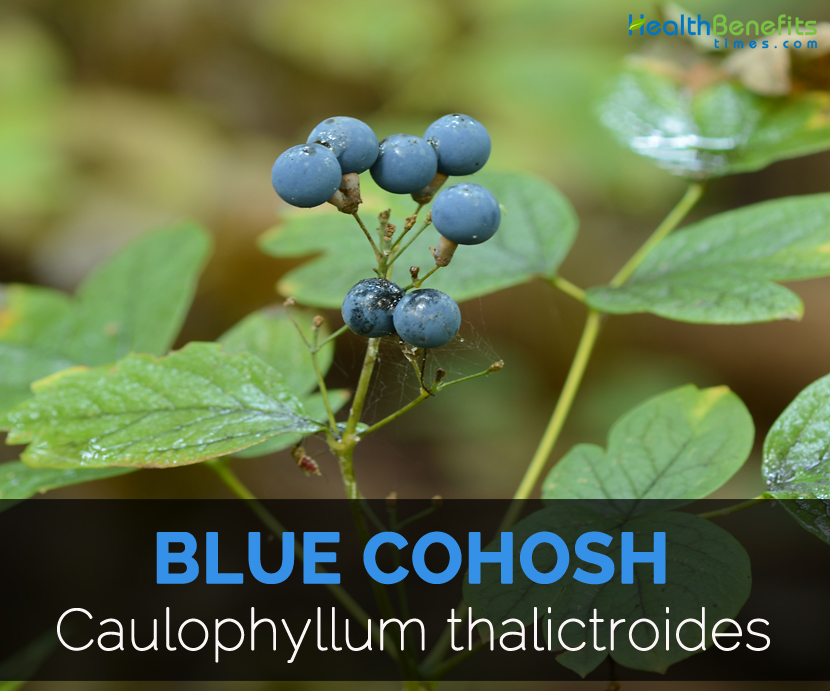| Blue Cohosh Quick Facts | |
|---|---|
| Name: | Blue Cohosh |
| Scientific Name: | Caulophyllum thalictroides |
| Origin | Commonly found in northern Illinois, central Illinois and Shawnee Hills of southern Illinois. |
| Colors | Initially green but bright blue at maturity |
| Shapes | 1/3" across, globoid, glaucous, glabrous |
History
Mostly used by Native Americans, the word cohosh was derived from Algonquin name. Potawatomi, Okibwe, Meskawi, Menomini tribes used it for treating menstrual cramps, promote labor contractions and restrain excessive menstruation. From 19th century, it was used as parturient, emenagogue and antispasmodic in Eclectic medicine and is continuously used for promoting uterine contractions and regulates menstrual cycle.
Plant
Blue cohosh is a perennial wildflower which grows about 1-3′ high. It has rhizomatous and fibrous root system. It has light green to pale purple central stem that is terete, erect, glabrous which is often glaucous.
Leaves
The non-flowering plant bears single compound leaf whereas the flowering plant bears a couple compound leaves at the apex of stem. A flowering plant has lower compound leaf that is found at the middle of the central stem that could be divided into 3 compound leaflets. Every leaflet is composed of 9 subleaflets. The leaflets are ascending, glabrous, long and light green in color. The subleaflets measuges about ¾-2″ across (wide) and 1-3″ long and is broadly ovate-oblong to obovate-oblong with blunt tips.
Flower
Each flower measures 1/3″ across that comprises of insignificant petals, 6 petaloid sepals, 6 stamens with an ovoid ovary. The sepals are oblanceolate which might be greenish brown, greenish yellow or greenish purple that depends on local ecotype. From 3 to 4 green bractlets could be found underneath of each flower. The flower blooms from mid to late spring before the leaves are developed fully. Then the flowers are followed by the berry that is like seeds.
Seeds
Seeds are globoid in shape, glacous and glabrous that measures about 1/3″ across. Firslty, the seeds are green but later on turns bright blue when it becomes mature. The seed coat consists of carbohydrates and is fleshy.
Traditional uses
- It is used to facilitate child birth in North American Indian tribes.
- It is a treatment for gynaecological conditions.
- This herb is used to eliminate intestinal worms and also lowers inflammation.
- The root possesses antispasmodic, anthelmintic, diuretic, diaphoretic, oxytocic, emenagogue and sedative properties.
- Drink an infusion made with root and warm water for two weeks to ease birth.
- Internally, the plant is used to treat rheumatism, pelvic inflammatory disease and gout.
- The root is used as an aid for menstrual disorders.
- It is useful for uterine inflammation, hysteria and epilepsy.
- It stops uterine bleeding after delivery.
- It is used as a contraceptive by native Americans.
Precautions
- It is not supposed to be used during pregnancy.
- Its excessive use should be avoided because it might cause nicotine poisoning and high blood pressure.
- Its overdose might cause vomiting, nausea and narrowing of blood vessels.
- It should not be used by the people having heart diseases and hypertension.
- It might irritate mucous membranes and cause contact dermatitis.
- The people who are allergic to Blue cohosh should not use it.
- Side effects such as irritation of gastrointestinal system, chest pain, cramps, severe diarrhea, high blood pressure and high blood glucose levels might be experienced.
How to Eat
- The seeds are roasted and used as a substitute for coffee.
References:
https://www.itis.gov/servlet/SingleRpt/SingleRpt?search_topic=TSN&search_value=18840#null
http://davesgarden.com/guides/pf/go/2644/
http://pfaf.org/user/Plant.aspx?LatinName=Caulophyllum+thalictroides
https://www.nps.gov/plants/MEDICINAL/plants/caulophyllum_thalictroides.htm
https://www.drugs.com/npp/blue-cohosh.html
http://www.botanical.com/botanical/mgmh/c/cohblu84.html
http://www.medicalhealthguide.com/herb/bluecohosh.htm
Comments
comments
